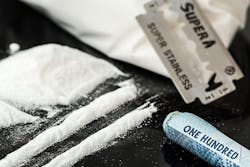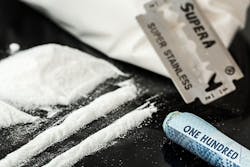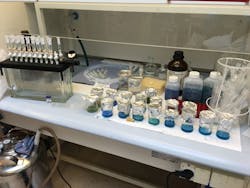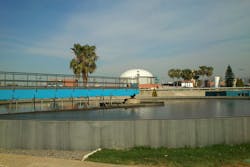Breaking Bad Habits - Wastewater Analysis Reveals Illegal Drug Movement in Europe
Wastewater analysis has become a rapidly developing technique to produce near real-time data on geographical trends in illicit drug use. This article looks at results from a recent study.
By Andrew Williams
It was in late December 2016 when a group of European researchers published the latest findings of a large scale project focused on the emerging science of wastewater analysis and drug-taking.
For the study, Europe-wide SCORE group and the European Monitoring Centre for Drugs and Drug Addiction (EMCDDA) analysed wastewater in more than 50 European cities across 18 European countries in March 2016 to explore the drug-taking behaviours of their inhabitants. Over a one week period, they analysed daily wastewater samples taken from the catchment areas of wastewater treatment plants (WWTPs) across the continent, equating to approximately 25 million people, for traces of four illegal drugs: amphetamine, cocaine, MDMA (ecstasy) and methamphetamine.
Among other things, the team detected raised levels of methamphetamine use in eastern Germany and northern Europe, particularly in Finnish cities. It also found evidence for large-scale cocaine use in cities across Belgium, the Netherlands, Spain and the UK, as well as ‘sharp increases’ in MDMA use in some cities.
Treatment Needs
In basic terms, wastewater analysis involves the sampling of a source of wastewater, such as a sewage influent to a wastewater treatment plant, which allows scientists to estimate the quantity of drugs consumed by a community by measuring the levels of illicit drugs and their metabolites excreted in urine.
As Dr. Liesbeth Vandam, Scientific Coordination Analyst at EMCDDA, explains, the technique is now recognised as a “rapidly developing scientific discipline with the potential for monitoring near-real-time data on geographical and temporal trends in illicit drug use”.
Even so, she admits that monitoring drug use is a very tricky exercise, largely by virtue of the hidden and complex nature of drug use, with no “single measure” capable of providing an overall picture of drug behaviours. This has prompted the centre to adopt what she describes as a multi-indicator approach.
“The strength of wastewater analysis is that it can provide us with timely information on geographical and temporal patterns of drug use ... at population level. Wastewater-based epidemiology has demonstrated its potential to become a useful complement to established drug monitoring tools, [and] its ability to deliver almost real-time data on drug use patterns is particularly relevant against the backdrop of an ever-shifting drugs problem,” she says.
“By detecting changes in drug use patterns, both geographically and over time, it can help health and treatment services respond better to emerging trends and changing treatment needs,” she adds.
Limitations
Lubertus Bijlsma, Doctor in Analytical Chemistry at Universitat Jaume I in Spain, and a core member of the SCORE group, agrees that the main advantage of the approach is that it provides “evidence based, objective and near-real-time information of drug use in large communities”.
“It is a cost effective and rapid method for acquiring quantitative data on the scale of drug use. This method does not rely on interviewing individuals. The social taboo related to illicit drug use might provoke non-participation and false responses in such surveys that makes these methods vulnerable and potentially inaccurate,” he says.
However, Vandam admits that it “cannot provide information on prevalence and frequency of use, main classes of users and purity of the drugs”.
She also points out that further challenges arise from the “uncertainties associated with the sampling of wastewater, the behaviour of the selected biomarkers in the sewer, the reliability of inter-laboratory analytical measurement, different back-calculation methods and different approaches to estimate the size of the population being tested”.
“To overcome some of these challenges the SCORE group uses a standard protocol and a common quality-control exercise in all locations, making it possible to directly compare illicit drug loads in Europe over a one-week period,” she says.
Bijlsma agrees that the technique is only currently able to provide data on the overall scale of drug use, or the amount used over time, and cannot provide any insight into who or why people are using drugs. Nor can it provide any socio-demographic information or other supporting data such as negative health outcomes or education issues, which he says could be used to design campaigns to reduce the effects of drug use.
“One of the biggest challenges we face is expanding the network to cover more and more of the total population. This is because such a network requires a huge amount of cooperation and coordination. The logistics of collecting samples and having those shipped to appropriately qualified laboratories are not small tasks,” he says.
“Our other big challenge is in gaining the support of traditional epidemiologists. This is slowly changing with the help and support of EMCDDA, but this has been a long process,” he adds.
Epidemiological Community
There are growing signs that Bijlsma is correct in his assessment that the epidemiological community is beginning to wake up to the potential of the new technique.
For example, Matthew Hickman, Professor of Public Health and Epidemiology at the University of Bristol, welcomes the fact that wastewater analysis offers some potential for improving epidemiologists’ understanding of drug use variation and trends. “We don’t expect wastewater-based measures to replace more traditional indicators of drug use across Europe, such as numbers of drug-related deaths and numbers in treatment, but we think they have a role in improving overall understanding,” he says.
Dr. Hayley Jones, Research Fellow in Medical Statistics at the University of Bristol, agrees that there are a number of key advantages to using the technique, including the fact that wastewater analysis provides objective measures of drug use that are not self-reported and that samples can be collected and chemically analysed relatively quickly, as opposed to surveys, which she says take a long time to carry out and analyse.
That said, Jones still argues there are several important limitations, such as the fact that estimates of population drug consumption based on wastewater analysis are based on ‘many other assumptions’ relating to how the drug is metabolised in the body, the size of the population using the sewerage system and the total volume of sewage passing through the system each day.
As such, she warns that measures of absolute drug consumption, for example the exact amounts consumed per 1000 population, based on wastewater analysis ‘should be interpreted with extreme caution.’
“Comparisons over time and between locations have more potential to be informative, but we still need to be careful in interpreting these: other factors could also contribute to apparent differences. For example, differences in sewerage system characteristics or differences in population diet across locations in Europe could affect how a drug is metabolised,” she says.
“Potentially the most useful contribution of wastewater could be in measuring whether an intervention in a particular location has had any effect on drug consumption. Wastewater with other data can be used to assess the impact of different interventions such as changes in the law,” she adds.
Biomarkers
Looking ahead, Hickman also stresses that the collection of wastewater samples is currently logistically difficult, at least in most areas of the UK, meaning that the collaboration of wastewater companies is crucial for ongoing routine analysis to become feasible.
Ideally, he argues that wastewater collected for other purposes by wastewater companies could be used for epidemiology, helping to reduce the burden of collection. Moreover, because the geography of UK sewerage systems is complicated, he believes that the “establishment of an effective sampling system, rather than collecting from every site, will be important”.
“Another important challenge is our limited understanding of how these drugs are metabolised in the body and, as such, the relationship between consumption and how much of a chemical analyte is excreted,” he says.
“The key is to combine innovation in chemistry and engineering, such as automated collection devices, with other more prosaic epidemiological and sampling theory so we can develop an effective ongoing monitoring system.”
A New Technique
Although wastewater-based epidemiology has already established itself as an important tool for monitoring illicit drug use, Vandam also believes there are a number of future directions for wastewater research to explore.
To begin with, she reveals that wastewater analysis has been proposed as a tool to address some of the challenges related to the dynamic new psychoactive substances (NPS) market - including the “large number of individual NPS, the relatively low prevalence of use and the fact that many of the users are unaware of exactly which substances they are taking”.
A new technique has already been established to identify NPS, involving the collection and analysis of pooled urine from stand-alone portable urinals from nightclubs, city centres and music festivals, providing what Vandam describes as “timely data on exactly which substances are currently in use at a particular location”.
“Wastewater-based epidemiology can potentially provide information not only on illicit drugs, alcohol, tobacco and the misuse of medicines, but also about health and illness indicators within a community, “ she says.
“The potential for wastewater based epidemiology to be used as an outcome measurement tool, in particular in the evaluation of the effectiveness of interventions that target drug supply or drug demand has not yet been fully explored. Close collaboration between the different stakeholders involved, including epidemiologists, wastewater experts and legal authorities, is highly recommended in order to start examining these potential wastewater based applications,” she adds.
Over the next few years, Bijlsma says that new developments in the field of biosensors and other on-line monitoring techniques are also very promising for analysing human metabolic excretion products, or biomarkers, in wastewater.
“In the near future, however, I expect that the greatest innovations will be made in the extension of this approach to other aspects of public health. For example population-health biomarkers, disease markers, human exposure to environmental pollutants ... the possibilities are countless. You could say wastewater is the mirror of society,” he adds.
Andrew Williams is based in the UK and is a freelance contributor for WWi magazine.
More Water & WasteWater International Archives Issue Articles




